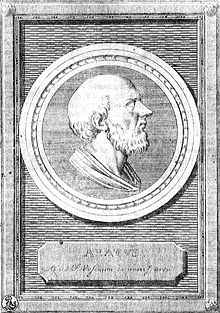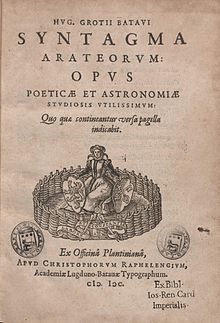Aratus

Aratus(/əˈreɪtəs/;Greek:Ἄρατος ὁ Σολεύς;c. 315/310 – 240 BC) was aGreekdidacticpoet.His major extant work is hishexameterpoemPhenomena(Greek:Φαινόμενα,Phainómena,"Appearances";Latin:Phaenomena), the first half of which is a verse setting of a lost work of the same name byEudoxus of Cnidus.It describes theconstellationsand other celestial phenomena. The second half is called theDiosemeia(Διοσημεῖα "Forecasts" ), and is chiefly about weather lore. Although Aratus was somewhat ignorant ofGreek astronomy,his poem was very popular in the Greek and Roman world, as is proven by the large number of commentaries andLatintranslations, some of which survive.
Life[edit]
There are several accounts of Aratus's life by anonymous Greek writers, and theSudaand Eudocia also mention him. From these it appears that he was a native ofSoli[1]inCilicia,(although one authority saysTarsus). He is known to have studied withMenecratesinEphesusandPhilitasinCos.As a disciple of the Peripatetic philosopherPraxiphanes,inAthens,he met theStoicphilosopherZeno,as well asCallimachusofCyreneandMenedemus,the founder of theEretrian school.
About 276 BC Aratus was invited to the court of theMacedoniankingAntigonus II Gonatas,whose victory over theGaulsin 277 Aratus set to verse. Here he wrote his most famous poem,Phenomena.He then spent some time at the court ofAntiochus I SoterofSyria,but subsequently returned toPellain Macedon, where he died sometime before 240/239.[2][3]His chief pursuits weremedicine(which is also said to have been his profession),grammar,andphilosophy.
Writings[edit]
Several poetical works on various subjects, as well as a number of prose epistles, are attributed to Aratus, but none of them have come down to us, except his two astronomical poems inhexameter. These have generally been joined as parts of the same work; but they seem to be distinct poems, the first, calledPhenomena( "Appearances" ), consists of 732 verses; the second,Diosemeia( "On Weather Signs" ), of 422 verses.
Phenomena[edit]


ThePhenomenaappears to be based on two prose works—PhenomenaandEnoptron(Ἔνοπτρον, "Mirror", presumably a descriptive image of the heavens)—byEudoxus of Cnidus,written about a century earlier. We are told by the biographers of Aratus that it was the desire of Antigonus to have them turned into verse, which gave rise to thePhenomenaof Aratus; and it appears from the fragments of them preserved byHipparchus,that Aratus has in fact versified, or closely imitated parts of them both, but especially of the first.
The purpose of thePhenomenais to give an introduction to theconstellations,with the rules for their risings and settings; and of the circles of the sphere, amongst which theMilky Wayis reckoned. The positions of the constellations, north of theecliptic,are described by reference to the principal groups surrounding the north pole (Ursa Major,Ursa Minor,Draco,andCepheus), whilstOrionserves as a point of departure for those to the south. The immobility of theEarth,and the revolution of the sky about a fixed axis are maintained; the path of theSunin thezodiacis described; but theplanetsare introduced merely as bodies having a motion of their own, without any attempt to define their periods; nor is anything said about the Moon's orbit. The opening of the poem asserts the dependence of all things uponZeus.From the lack of precision in the descriptions, it would seem that Aratus was neither a mathematician nor observer[4]or, at any rate, that in this work he did not aim at scientific accuracy. He not only represents the configurations of particular groups incorrectly, but describes some phenomena which are inconsistent with any one supposed latitude of the spectator, and others which could not coexist at any one epoch. These errors are partly to be attributed to Eudoxus himself, and partly to the way in which Aratus has used the materials supplied by him. Hipparchus (about a century later), who was a scientific astronomer and observer, has left a commentary upon thePhenomenasof Eudoxus and Aratus, accompanied by the discrepancies which he had noticed between his own observations and their descriptions.
Published editions[edit]
- Phaenomena(in Latin). Leiden: Officina Plantiniana. 1600.
Diosemeia[edit]
TheDiosemeiaconsists of forecasts of theweatherfrom astronomical phenomena, with an account of its effects upon animals. It appears to be an imitation ofHesiod,and to have been imitated byVirgilin some parts of theGeorgics.[2] The materials are said to be taken almost wholly fromAristotle'sMeteorologica,from the work ofTheophrastus,On Weather Signs,and from Hesiod. Nothing is said in either poem aboutHellenistic astrology.
Later influence[edit]
The two poems were very popular both in the Greek and Roman world,[5]as is proved by the number of commentaries and Latin translations. He enjoyed immense prestige amongHellenisticpoets, includingTheocritus,CallimachusandLeonidas of Tarentum.This assessment was picked up byLatinpoets, includingOvidandVirgil.Latinversions were made by none other thanCicero(mostly extant),[2][6]Ovid (only two short fragments remain), the member of theimperial Julio-Claudian dynastyGermanicus(extant, withscholia), and the less-famousAvienius(extant). Quintilianwas less enthusiastic.[2] Aratus was also cited by the author ofActs(believed to beLuke the Evangelist), inActs 17:28,where he relatesSaint Paul's address on theAreopagus. Paul, speaking ofGod,quotes the fifth line of Aratus'sPhenomena(Epimenidesseems to be the source of the first part ofActs 17:28,[2]although this is less clear):
Ἐκ Διὸς ἀρχώμεσθα, τὸν οὐδέποτ' ἄνδρες ἐῶμεν |
Let us begin with Zeus, whom we mortals never leave unspoken. |
| —Phenomena1–5 |
Authors of twenty-seven commentaries are known; ones byTheon of Alexandria,Achilles TatiusandHipparchus of Nicaeasurvive. AnArabictranslation was commissioned in the ninth century by theCaliphAl-Ma'mun.He is cited byVitruvius,Stephanus of ByzantiumandStobaeus.Several accounts of his life are extant, by anonymous Greek writers.[2]
The craterAratuson theMoonand the minor planet12152 Aratusare named in his honour.
See also[edit]
Notes[edit]
References[edit]
- This article incorporates text from a publication now in thepublic domain:Chisholm, Hugh,ed. (1911). "Aratus of Soli".Encyclopædia Britannica.Vol. 2 (11th ed.). Cambridge University Press. p. 321.
 This article incorporates text from a publication now in thepublic domain:Smith, William,ed. (1870)."Aratus".Dictionary of Greek and Roman Biography and Mythology.pp. 255–256.
This article incorporates text from a publication now in thepublic domain:Smith, William,ed. (1870)."Aratus".Dictionary of Greek and Roman Biography and Mythology.pp. 255–256.
Two important recent editions of Aratus's work:
- Douglas Kidd,Phaenomena,edited with introduction, translation and commentary, Cambridge, 1997.ISBN978-0-521-58230-8.
- Jean Martin,Aratos. Phénomènes,edited with translation and notes, 2 vols.,Collection Budé,1998.ISBN978-2-251-00470-9.
Further reading[edit]
- Bing, Peter. 1993. "Aratus and his Audiences."Materiali e Discussioni31:99–109.
- Faulkner, Andrew. 2015. "The Female Voice of Justice in Aratus' Phaenomena."Greece and Rome.62.1: 75–86
- Gee, Emma. 2013.Aratus and the Astronomical Tradition.Oxford: Oxford Univ. Press.
- Gee, Emma. 2000.Ovid, Aratus and Augustus: Astronomy in Ovid’s Fasti.Cambridge, UK: Cambridge Univ. Press
- Hunter, Richard L. 1995. "Written in the Stars: Poetry and Philosophy in the Phaenomena of Aratus."Arachnion2:1–34.
- James, Alan W. 1972. "The Zeus Hymns of Cleanthes and Aratus."Antichthon6:28–38.
- Katz, Joshua T. 2008. "Vergil Translates Aratus: Phaenomena 1–2 and Georgics 1.1–2."Materiali e discussioni per l'analisi dei testi classici60: 105–123
- Mastorakou, Stamatina. 2020. “Aratus’ Phaenomena beyond its sources”,Aestimatio1: 55-70.
- Mastorakou, Stamatina. 2020. “Aratus and the Popularization of Hellenistic Astronomy”. In Ancient Astronomy in Its Mediterranean Contexts (300 BC – 300 AD), A.C. Bowen and F. Rochberg (eds.), Brill, 383-397.
- Mastorakou, Stamatina. 2024. “Visualization of Astronomical Knowledge in Hellenistic Times: Aratus, Urania and the Celestial Globe”. InImagining the Heavens across Eurasia from Antiquity to Early Modernity.Edited by R. Brentjes, S. Brentjes, S. Mastorakou, Mimesis.
- Pendergraft, Mary L. B. 1995. "Euphony and Etymology: Aratus’ Phaenomena."Syllecta Classica6:43–67.
- Possanza, Mark. 2004.Translating the Heavens: Aratus, Germanicus, and the Poetics of Latin Translation.New York: Lang
- Volk, Katharina. 2010. "Aratus." InA Companion to Hellenistic Literature.Edited by James J. Clauss and Martine Cuypers, 197–210. Malden, MA: Wiley-Blackwell.
External links[edit]
- Online text: Aratus, Phenomena, translated by G. R. Mair, 1921
- Online text: Aratus, Phaenomena, Greek text
- Works by Aratus at Perseus Digital Library
- Audio:The Maiden (Virgo)an excerpt fromPhenomenaread by translator Aaron Poochigian
- The Apostle and the Poet: Paul and Aratus(Dr. Riemer Faber)
- Review of Kidd's translation of thePhenomenaby Mark Possanza,BMCR(September 1999).
- "Aratus and Aratea",A Hellenistic Bibliographyby Martin Cuypers
- "Written in the Stars:Poetry and Philosophy in the Phaenomena of Aratus"by Richard L. Hunter,Arachnion2.
- Suda On-Line: Aratus,with a list of works ascribed to Aratus; theSudais aByzantineencyclopedia.
- Phaenomena et prognostica, Coloniae Agrippinae 1570 da atlascoelestis
